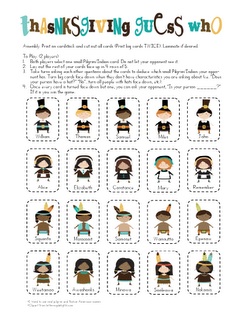Thanksgiving Guess Who? can be used for a wide range of listening and language targets such as auditory memory, auditory processing, deductive reasoning and a range of receptive and expressive language goals. For the game to work, both players must listen, comprehend and reply to each other’s questions accurately.
To Play: First, you will need to print out the game cards.
Number of players: 2 (more players can compete as teams)
• Description: Each player has a one set of 20 different Pilgrims and Indians. Both players select one small Pilgrim/Indian card. Do not let your opponent see it. Put remaining little cards away.
• Lay out your big cards face up in 4 rows of 5.
• Take turns asking each other questions about the cards to deduce which small Pilgrim/Indian your opponent has. Turn big cards face down when they don’t have characteristics you are asking about (i.e. “Does your person have a hat?” “No”...turn all people with hats face down, etc.).
• Once every card is turned face down but one, you can ask your opponent, “Is your person ______?”
If it is, you win the game!
Suggested Listening and Spoken Language Targets:
1. Describing Salient Features:
If your child often communicates by pointing or uses a lot of non-specific vocabulary like that, this, or thing, playing Guess Who? can contribute to using more specific descriptions. It is a good idea to look at the cards together beforehand and warm up by discussing the characters’ distinguishing features.
2. Question Formation:
Forming yes/no questions involve inverting the subject (e.g., your Pilgrim) with either the main verb (e.g., Is your Pilgrim a girl?) or the auxiliary verb as in (e.g., Does your Indian have two feathers in his headband?)
3. Is/Does Question Forms:
When using Thanksgiving Guess Who? for this purpose, require the child to ask all questions using one of two forms:
• Is your pilgrim wearing a bonnet_____?
• Does your Indian have a vest _____?
• Expect your child to answer using full sentences, not a simple yes or no.
4. Have/Has as well as Negation and Contractions:
There are four typical forms of an answer:
• Yes, my pilgrim has _____.
• No, my Indian doesn’t have _____.
• Yes, my pilgrim is _____.
• No, my Indian is not _____.
5. Using “Clear speech”:
Producing accurate /s/ and /z/ and other speech sounds can be highlighted in spontaneous speech For example: is, has, does, etc. Thanksgiving Guess Who? is a great exercise in self-monitoring and using clear speech.
Have fun!


No comments:
Post a Comment